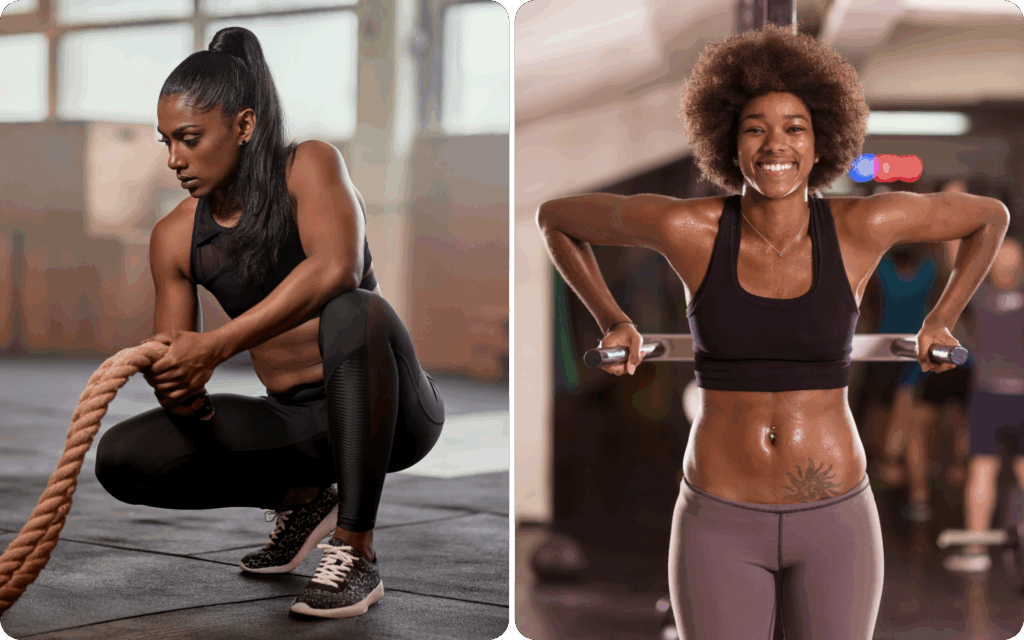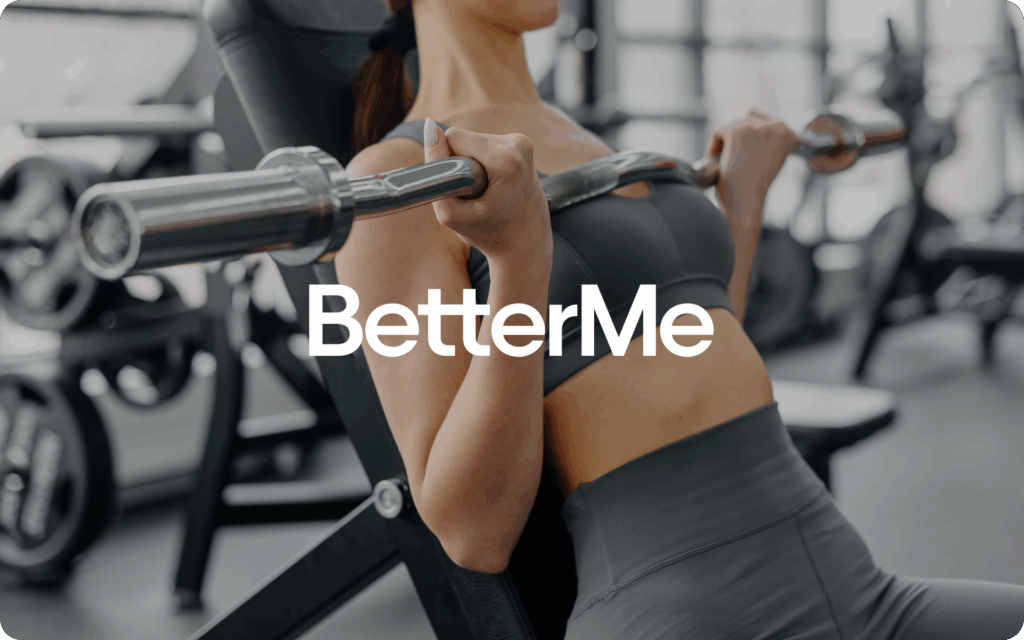The question of “how often should I work out?” is one of the most common and important questions for anyone who is beginning their fitness journey. As with many things in health and fitness, the answer will depend on your goals, current fitness level, and lifestyle.
However, most experts, including organizations such as the American College of Sports Medicine (ACSM) and the World Health Organization (WHO), agree on a general minimum guideline: adults should aim for at least 150 minutes of moderate-intensity aerobic activity or 75 minutes of vigorous activity per week, combined with muscle-strengthening exercises on two or more days (1, 2).
For beginners, this can feel like a daunting target. A well-structured, beginner-friendly workout plan that spans five days a week can help you meet these recommendations.
Read on to learn how to create a 5-day-a-week workout plan that works for you, regardless of your fitness level.
What Is a Structured 5-Day-a-Week Workout Plan?
A structured 5-day-a-week workout plan is a systematic approach to fitness that is designed to help you exercise consistently while addressing various key components of physical health. This type of plan organizes your week into focused sessions, varying the type and intensity of activity to balance effort and recovery. The structure ensures that you target multiple aspects of fitness in a sustainable way, including;
- Strength
- Cardiovascular health
- Mobility
- Recovery
This kind of regimen is adaptable to your goals, whether you’re aiming to build muscle, improve endurance, or simply establish a routine that boosts your overall health and energy.
By dedicating five days each week to physical activity, you’ll create space to develop skills, strengthen your body, and see measurable progress, all while incorporating enough rest to avoid burnout or injury.
What Does a 5-Day Workout Plan Entail?
At its core, a 5-day-a-week workout plan to build muscle involves strategically planning workouts to focus on different movements or muscle groups, ensuring comprehensive conditioning. It typically includes:
1. Varied Training Modalities
A balanced plan integrates various types of exercise. These may include:
- Strength Training for building strength and muscle and improving bone density (3).
- Cardiovascular Work for heart health and endurance (4).
- Mobility and Flexibility Exercises to enhance range of motion and prevent injury (5).
- Active Recovery such as yoga or light stretching to promote rest while maintaining movement (6).
2. Progression Over Time
The intensity and volume of workouts progressively increase as your fitness improves. This gradual adaptation prevents plateaus and keeps the routine challenging and engaging (7).
BetterMe: Health Coaching app helps you achieve your body goals with ease and efficiency by helping to choose proper meal plans and effective workouts. Start using our app and you will see good results in a short time.
3. Balanced Recovery
Rest doesn’t just happen on “off” days. A well-designed schedule incorporates low-intensity movement and restorative practices, enabling your body to recover while maintaining momentum.
4. Personalization for Fitness Levels
Whether you’re a beginner learning the basics, an intermediate ready to build on a solid foundation, or an advanced athlete seeking peak performance, the plan is tailored to meet your current capabilities and goals.
By covering these bases, a 5-day program improves muscular strength, cardiovascular resilience, flexibility, and mental clarity. Equally important, it trains consistency – a key to long-term success.
Read more: 3-Day Full-Body Gym Workout for Female Beginners
How to Structure a 5-Day Plan
Creating an effective 5-day workout plan involves aligning your week with targeted workouts that cater to your fitness level. Below is a breakdown for beginners, intermediates, and advanced individuals:
Beginner-Friendly 5-Day Workout Plan
For those who are new to working out, focus should be on mastering fundamental movements, avoiding overexertion, and building a habit of consistency.
- Day 1: Full-body strength training
Perform fundamental compound movements like squats, push-ups, and rows in 2-3 sets of 10-12 reps. Use light weights or body weight to focus on form.
- Day 2: Low-intensity cardio
Enjoy 30 minutes of brisk walking, cycling, or swimming to elevate your heart rate without undue fatigue.
- Day 3: Active recovery
Practice yoga or complete dynamic stretches to improve flexibility and reduce stiffness.
- Day 4: Upper body + core strength
Incorporate exercises such as overhead presses, bicep curls, and planks. Keep weights light and prioritize control during movements.
- Day 5: Lower body strength + light cardio
Combine lower-body exercises (e.g. lunges, glute bridges) with 20 minutes of easy cycling or jogging to boost endurance.
Key Insights for Beginners:
- Choose lighter weights or resistance bands to avoid strain.
- Rest for 30-60 seconds between sets for recovery.
- Focus on developing proper movement patterns rather than seeking maximum intensity.
Days 6-7: Total rest days
Intermediate 5-Day Workout Plan
For those with some experience, the aim is to build and gradually increase the load used and intensity levels while also moving to bigger free weight exercises.
- Day 1: Push (chest, shoulders, triceps)
Exercises could include the bench press, overhead press, and tricep dips. Perform 3-4 sets of 8-10 reps with moderate weights.
- Day 2: Cardio Intervals
Alternate between 1 minute of high-intensity effort (such as sprint cycling) and 2 minutes of low-intensity recovery for 20-30 minutes.
- Day 3: Pull (back, biceps, core)
Incorporate pull-ups or lat pulldowns, dumbbell rows, and Russian twists for a strong posterior chain.
- Day 4: Lower-body strength
Focus on deadlifts, goblet squats, and calf raises. Add resistance gradually to build leg power.
- Day 5: Hybrid day (strength and cardio blend)
Combine kettlebell swings, box jumps, and rowing machine sprints for a circuit-style workout.
Key Insights for Intermediates:
- Track your weights and reps to ensure progression.
- Allow for longer effort in high-intensity intervals as your endurance improves.
- Experiment with supersets or circuits to keep workouts dynamic.
Days 6-7: Total rest days
Advanced 5-Day Workout Plan
Advanced athletes often split workouts by muscle groups or performance metrics, as this allows more focus on fine-tuning strength, power, and agility.
- Day 1: Strength (lower body, heavy weights)
Prioritize barbell squats, Romanian deadlifts, and weighted lunges. Perform 5-6 sets of 4-6 reps at near-maximal loads.
- Day 2: Plyometrics and anaerobic conditioning
Perform explosive movements such as jump squats, broad jumps, and sprint intervals. Focus on power output.
- Day 3: Strength (upper body, hypertrophy focus)
Use exercises such as incline presses, pull-ups, and dips with moderate to heavy weights. Aim for 3-4 sets of 10-12 reps.
- Day 4: Endurance cardio or functional fitness
Run or cycle a long distance at a steady pace, or incorporate CrossFit-style WODs.
- Day 5: Active recovery and mobility
Use foam rolling, deep stretching, and light yoga to reset your body for the next week.
Key Insights for Advanced Trainees:
- Consider using periodization to focus on different performance goals over time. This means switching up your workouts after 3-6 months.
- Track metrics such as time-to-fatigue or 1-rep max to gauge progress.
- Prioritize recovery techniques such as yoga, Pilates, or mobility drills to reduce injury risk.
Is a 5-Day-a-Week Workout Enough?
For most individuals, a 5-day training schedule strikes an ideal balance between effort, recovery, and overall sustainability. The key is how those five days are structured.
A well-designed 5-day workout plan can address all the essential aspects of fitness, including strength, endurance, mobility, and recovery. By incorporating varied training modalities, you’ll ensure that your workouts are comprehensive and effective without overloading the body. For example:
- Strength Training for Muscle Growth and Bone Health: Allocating 2-3 days to resistance training ensures progressive strength and muscle development.
- Cardiovascular Activity for Heart and Lung Health: Dedicating 1-2 days to moderate or high-intensity cardio enhances endurance and caloric expenditure.
- Mobility and Recovery: Including active recovery days – such as light yoga or flexibility exercises – promotes muscle recovery and reduces soreness.
The principle of recovery is equally important. When programmed correctly, five days of exercise allows the body to adapt and grow stronger while still leaving room for low-intensity or rest days. Overtraining often stems not from the number of days but from improper recovery, excessive intensity, or ignoring early signs of fatigue (8).
For most fitness goals, including weight management, muscle building, or general health improvement, five sessions a week are sufficient.
Can Beginners Handle 5 Days a Week of Training?
The thought of exercising five days a week can feel overwhelming to beginners, but with the right approach, it’s both achievable and beneficial. The key lies in moderation, planning, and understanding your body’s signals.
Although beginners are new to structured exercise, their plans should prioritize lower intensity and volume. Focusing on building habits rather than overloading intensity reduces the likelihood of overtraining.
Here’s how a 5-day-a-week workout plan for beginners may look:
- 2-3 Days of Strength Work: Use light weights and fundamental movements such as bodyweight squats, push-ups, and rows.
- 1-2 Days of Light Cardio: Activities like brisk walking or cycling keep the heart rate elevated without excessive strain.
- 1 Day of Active Recovery: Gentle mobility exercises or restorative yoga help the muscles recover.
BetterMe will shake off your mental funk, rid you of your energy-zapping habits, and help you sculpt the body of your dreams. Intrigued? Hurry up and change your life for the better!
The most important factor for beginners is to listen to their bodies. Overtraining or injury often happens when people push too hard, too soon. Key strategies include:
- Start Slow: Begin with low-intensity workouts and shorter durations. Gradually increase the workload as your body adapts.
- Prioritize Recovery: Ensure at least one rest day in the week and avoid back-to-back high-intensity sessions.
- Focus on Form: Perfect technique before increasing weights or pace. Quality beats quantity in the early stages.
- Monitor Energy Levels: Fatigue, poor sleep, or lingering soreness are signs to reduce intensity or take a rest day.
For beginners, recovery extends beyond just skipping a day at the gym. Nutrition, hydration, and quality sleep play huge roles in how well the body adapts to new activity levels. Combining light active recovery sessions with proper rest ensures progress without burnout (9).
Is It OK to Do the Same Workout 5 Days a Week?
While it may seem straightforward to repeat the same workout every day, doing so comes with significant limitations and risks. The primary concern is overuse, which occurs when the same movements are repeatedly performed without adequate recovery. Over time, this puts excessive strain on your:
- Muscles
- Joints
- Connective tissues
This can lead to fatigue, poor performance, and even injury.
Repetitive routines restrict your progress and can cause imbalances in muscle development. Here are the key reasons why varying your workouts is essential:
- Muscle Recovery: When the same muscles are worked daily, they don’t have time to repair and grow, which is essential for strength and endurance development. Active recovery allows better performance in subsequent workouts (10).
- Balanced Development: Focusing on the same movement patterns or muscle groups can create imbalances, leaving certain areas overdeveloped and others undertrained. This imbalance increases your risk of pain and injury (11).
- Mental Engagement: Repeating the same workout often leads to boredom, which makes it harder to stay motivated. A varied routine keeps the mind stimulated and committed to consistent progress.
- Adaptation: Your body adapts to repetitive stress over time, which can lead to performance plateaus. Variability keeps muscles and systems challenged for continuous improvement (12).
Instead of repeating one routine, you should aim for a program that alternates muscle groups, training styles, and intensities. For example:
- Divide the week into strength, cardio, and mobility-focused sessions.
- Use workout variations such as changing the resistance, rep ranges, or type of exercise (e.g. replacing bodyweight squats with weighted goblet squats).
By incorporating variety, you’ll foster well-rounded fitness, ensure lasting progress, and reduce the likelihood of overtraining.
Read more: Easy Home Workout Plan for Women: Exercises, Tips, and FAQs
How to Balance Muscle Groups Across 5 Weekly Sessions
To ensure balanced muscle development, many professionals recommend split training – a structure that targets different muscle groups or movement patterns on specific days. Doing so offers several training benefits, including:
- Reduces overuse
- Ensures recovery between sessions
- Allows for more focus on each area
Together, these can allow for a more optimized and targeted training program.
What Is Split Training?
Split training separates your workout week by muscle groups, such as focusing on upper body one day and lower body another. It can also sometimes involve dividing workouts by training objectives, such as strength, endurance, or mobility. This creates a balanced program that targets all the major muscle groups over the course of the week.
The advantage of split training is that it provides adequate recovery time to prevent overuse while allowing for effective intensity and volume (13). This targeted approach ensures well-rounded progress. Our previous post goes into great detail about the bodyweight workout split.
Here’s how split routines can be structured, with examples:
Beginner-Friendly Split
Beginners benefit from a simpler plan that introduces fundamental movements and prioritizes recovery.
- Day 1: Full-body strength – Compound movements such as squats, push-ups, and rows.
- Day 2: Light cardio – 30 minutes of brisk walking or cycling.
- Day 3: Upper-body focus – Exercises such as overhead presses, bicep curls, and planks.
- Day 4: Lower-body strength – Lunges, glute bridges, and hamstring stretches.
- Day 5: Active recovery – Yoga or dynamic mobility exercises.
This plan is gentle on recovery needs while hitting all major muscle groups.
Intermediate Split
Intermediate individuals can handle more volume and intensity while focusing on different muscle groups daily.
- Day 1: Push (chest, shoulders, triceps) – Exercises include bench press, shoulder press, and dips.
- Day 2: Pull (back, biceps, core) – Rows, chin-ups, and twisting core exercises.
- Day 3: Leg day – Compound lifts such as squats and accessory moves like calf raises.
- Day 4: Cardio or hybrid session – High-intensity interval training (HIIT) or circuit training.
- Day 5: Active recovery – Foam rolling, stretching, and controlled yoga flows.
This routine ensures each muscle group is worked thoroughly while integrating conditioning and mobility.
Advanced Split
Advanced athletes focus on specific muscle groups with higher intensity and precision.
- Day 1: Heavy lower body – Barbell squats, deadlifts, and split squats.
- Day 2: Chest and back combo – Alternating push-pull patterns with exercises such as incline press and pull-ups.
- Day 3: Speed and power – Plyometric drills such as box jumps, sprints, and kettlebell swings.
- Day 4: Upper body hypertrophy (arms and shoulders) – Bicep curls, tricep extensions, and lateral raises.
- Day 5: Mobility and core – Stability drills, anti-rotational exercises, and full-body stretching.
This plan maximizes strength, power, and mobility while ensuring sufficient recovery time between muscle groups.
Check out our previous article to learn which muscle groups to work together for better muscle gain results.
How to Avoid Overtraining with 5-Day Weekly Workouts
The first step to avoiding overtraining is to understand its symptoms. Recognizing these early warning signs allows you to adjust your routine before causing harm. Watch for (14):
- Persistent Fatigue: Feeling constantly tired, even after a good night’s sleep.
- Decreased Performance: Struggling to lift weights, run, or complete exercises you could easily handle before.
- Muscle Soreness That Lingers: Chronic muscle stiffness or soreness that doesn’t improve with rest.
- Irritability or Mood Swings: Increased anxiety, frustration, or general irritability can stem from physical stress.
- Sleep Disruption: Trouble falling or staying asleep, even when you’re exhausted.
- Frequent Illness or Injuries: A weakened immune system and recurring injuries are common in overtraining.
These symptoms indicate that your body isn’t recovering effectively and signal the need for adjustments to your routine.
The Role of Recovery in a 5-Day Workout Schedule
Recovery isn’t just about resting, it’s also the critical phase during which your muscles repair, grow stronger, and adapt to the demands of your training. Adequate recovery helps you build a sustainable workout routine without overloading your system.
Recovery involves several elements, including:
- Sleep
- Nutrition
- Movement
- Stress management (9)
A properly designed program incorporates these aspects to maximize the benefits of your workouts while minimizing the risks.
Strategies to Prevent Overtraining
Prevention is much easier than dealing with the consequences of overtraining. Here are some actionable strategies to help balance a 5-day training schedule:
1. Plan Your Workouts Strategically
- Vary Intensity Across the Week: Alternate high-intensity workouts (e.g. heavy strength training or HIIT) with moderate or low-intensity days (e.g. light cardio or active recovery).
- Target Different Muscle Groups: Use a split training approach to give specific muscle groups time to recover while working others. For example, perform upper-body exercises on one day and lower-body exercises on another.
- Limit the Duration: Keep workouts between 45 and 75 minutes to avoid excessive fatigue.
2. Prioritize Active Recovery
Active recovery supports muscle repair and helps reduce soreness while keeping you moving. Activities such as yoga, stretching, or a leisurely walk can improve blood circulation and flexibility without adding extra strain (10).
3. Listen to Your Body
Your body provides reliable feedback if you pay attention. If you notice persistent soreness, fatigue, or a general sense of burnout, it’s important to adjust:
- Take a rest day if needed, even if it’s unscheduled.
- Modify workout intensity instead of pushing through discomfort.
- Track your energy levels to identify patterns of fatigue or overexertion.
4. Make Sleep a Priority
Sleep is one of the most powerful recovery tools. During deep sleep, your body repairs tissues, regulates hormones, and rebuilds energy stores (15). Aim for:
- 7-9 hours of quality sleep per night.
- Establishing a calming bedtime routine to improve sleep consistency.
5. Fuel Your Body with Nutritious Foods
What you eat significantly impacts your recovery and performance (16). Focus on:
- Protein: For muscle repair and growth. Aim for 20-30 grams per meal, depending on your activity level.
- Carbohydrates: To replenish your glycogen stores and sustain energy. Choose whole grains, fruits, and vegetables.
- Healthy Fats: To support hormone production and joint health. Add sources such as avocado, nuts, and olive oil.
- Hydration: Proper hydration enhances blood flow and nutrient delivery to your muscles. Drink water consistently throughout the day.
6. Factor in Restorative Practices
Use recovery techniques such as:
- Foam rolling
- Massage
- Deep breathing
These practices can help reduce muscle tension and promote relaxation, which will keep both your physical and mental stress levels in check.
7. Avoid the “No Pain, No Gain” Mindset
This outdated philosophy can lead to overtraining by encouraging you to ignore warning signals from your body. Instead, focus on:
- Sustainable progress rather than overexertion.
- Viewing rest as part of the process, not a setback.
It’s not recommended to perform full-body workouts five days in a row. While full-body routines are efficient for targeting multiple muscle groups, they require adequate recovery time for muscle repair and growth. Without rest, you risk overuse, fatigue, and even injury. A better approach would be to space out full-body sessions, incorporating rest or lighter activity days between them. Alternatively, consider split training to target specific muscle groups on different days for more effective recovery. We highlighted a sample 5-day workout split for beginners in a previous blog post. With a 5-day workout schedule, rest and recovery are essential for optimizing performance and preventing overtraining. Here’s a simple guideline: For example, you can train Monday and Tuesday, rest on Wednesday, then use Thursday through Saturday for exercise, before resting on Sunday. The exact placement of rest days will depend on your intensity and recovery needs. While cardio can be done daily, the intensity and duration should be carefully managed. Low-intensity cardio, such as walking or cycling, is safe for everyday activity and supports recovery. However, high-intensity cardio or long endurance sessions should be limited to 2-3 days per week to allow your body time to recover and avoid excessive strain on your cardiovascular system and muscles. Training legs once a week may suffice for maintenance, but it’s not ideal for building strength, muscle mass, or balanced lower-body development. For optimal results, you should aim to train your legs at least twice weekly. Frequently Asked Questions
Should I do full-body 5 days a week?
How can I schedule rest days in a 5-day plan?
Can I do cardio every day?
Is training legs once a week enough?
The Bottom Line
A structured 5-day-a-week workout plan is more than a workout regimen, it’s a strategic approach to balancing effort and recovery, adapting to your fitness level, and achieving long-term results. By incorporating a variety of exercises and focusing on consistency, this plan supports your physical and mental well-being in a sustainable way.
DISCLAIMER:
This article is intended for general informational purposes only and does not serve to address individual circumstances. It is not a substitute for professional advice or help and should not be relied on for making any kind of decision-making. Any action taken as a direct or indirect result of the information in this article is entirely at your own risk and is your sole responsibility.
BetterMe, its content staff, and its medical advisors accept no responsibility for inaccuracies, errors, misstatements, inconsistencies, or omissions and specifically disclaim any liability, loss or risk, personal, professional or otherwise, which may be incurred as a consequence, directly or indirectly, of the use and/or application of any content.
You should always seek the advice of your physician or other qualified health provider with any questions you may have regarding a medical condition or your specific situation. Never disregard professional medical advice or delay seeking it because of BetterMe content. If you suspect or think you may have a medical emergency, call your doctor.
SOURCES:
- Physical Activity Guidelines (n.d., acsm.org)
- Physical activity (n.d., who.int)
- Adaptations to Endurance and Strength Training (2018, pmc.ncbi.nlm.nih.gov)
- Cardiovascular Adaptations to Exercise Training (2015, pubmed.ncbi.nlm.nih.gov)
- The Surprising Benefits of Performing Daily Mobility Exercises (2023, acefitness.org)
- A Systematic Review on the Effectiveness of Active Recovery Interventions on Athletic Performance of Professional-, Collegiate-, and Competitive-Level Adult Athletes (2019, journals.lww.com)
- INTEGRATION OF STRENGTH AND CONDITIONING PRINCIPLES INTO A REHABILITATION PROGRAM (2011, pmc.ncbi.nlm.nih.gov)
- Overtraining Syndrome as a Complex Systems Phenomenon (2022, frontiersin.org)
- Exploring the Science of Muscle Recovery (n.d., blog.nasm.org)
- Active Recovery: Reduce Fatigue and Enhance Performance (2020, issaonline.com)
- Balancing Act: Muscle Imbalance Effects on Musculoskeletal Injuries (2022, pmc.ncbi.nlm.nih.gov)
- A Subject-Tailored Variability-Based Platform for Overcoming the Plateau Effect in Sports Training: A Narrative Review (2022, pmc.ncbi.nlm.nih.gov)
- Mastering the Art of the Split Routine (2024, acefitness.org)
- Overtraining Syndrome: A Practical Guide (2012, pmc.ncbi.nlm.nih.gov)
- Sleep and muscle recovery: endocrinological and molecular basis for a new and promising hypothesis (2011, pubmed.ncbi.nlm.nih.gov)
- Role of nutrition in performance enhancement and postexercise recovery (2015, pmc.ncbi.nlm.nih.gov)




















